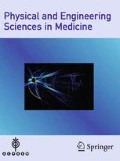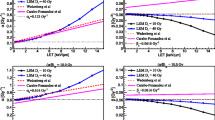Abstract
In recent years, there is an increased interest in using scanning modes in proton therapy, due to the more conformal dose distributions, thanks to the spot-weighted dose delivery. The dose rate in each spot is however much higher than the dose rate when using passive irradiation modes, which could affect the cell response. The purpose of this work was to investigate how the relative biological effectiveness changes along the spread-out Bragg peak created by protons delivered by the pencil beam scanning mode. Cell survival and micronuclei formation were investigated in four positions along the spread-out Bragg peak for various doses. Monte Carlo simulations were used to estimate the dose-averaged linear energy transfer values in the irradiation positions. The cell survival was found to decrease the deeper the sample was placed in the spread-out Bragg peak, which corresponds to the higher linear energy transfer values found using Monte Carlo simulations. The micronuclei frequencies indicate more complex cell injuries at that distal position compared to the proximal part of the spread-out Bragg peak. The relative biological effectiveness determined in this study varies significantly and systematically from 1.1, which is recommended value by the International Commission on Radiation Units, in all the studied positions. In the distal position of spread-out Bragg peak the relative biological effectiveness values were found to be 2.05 ± 0.44, 1.85 ± 0.42, 1.53 ± 0.38 for survival levels 90, 50 and 10%, respectively.








Similar content being viewed by others
References
Wilson RR (1946) Radiological use of fast protons. Radiology 47:487–491
Deluca PM (2007) The international commission on radiation units and measurements. J ICRU 7:v–vi. doi:10.1093/jicru/ndm020
Gerweck LE, Kozin SV (1999) Relative biological effectiveness of proton beams in clinical therapy. Radiother Oncol 50:135–142. doi:10.1016/S0167-8140(98)00092-9
Grégoire V, Pötter R, Wambersie A (2004) General principles for prescribing, recording and reporting a therapeutic irradiation. Radiother Oncol 73:S57–S61. doi:10.1016/S0167-8140(04)80015-X
Wambersie A, Hendry JH, Andreo P et al (2006) The RBE issues in ion-beam therapy: conclusions of a joint IAEA/ICRU working group regarding quantities and units. Radiat Prot Dosimetry 122:463–470. doi:10.1093/rpd/ncl447
Wambersie A, Menzel HG, Andreo P et al (2011) Isoeffective dose: a concept for biological weighting of absorbed dose in proton and heavier-ion therapies. Radiat Prot Dosimetry 143:481–486. doi:10.1093/rpd/ncq410
Matsumoto Y, Matsuura T, Wada M et al (2014) Enhanced radiobiological effects at the distal end of a clinical proton beam: in vitro study. J Radiat Res 55:816–822. doi:10.1093/jrr/rrt230
Tepper J, Verhey L, Goitein M et al (1977) In vivo determinations of RBE in a high energy modulated proton beam using normal tissue reactions and fractionated dose schedules. Int J Radiat Oncol 2:1115–1122. doi:10.1016/0360-3016(77)90118-3
Urano M, Goitein M, Verhey L et al (1980) Relative biological effectiveness of a high energy modulated proton beam using a spontaneous murine tumor In vivo. Int J Radiat Oncol 6:1187–1193. doi:10.1016/0360-3016(80)90172-8
Urano M, Verhey LJ, Goitein M et al (1984) Relative biological effectiveness of modulated proton beams in various murine tissues. Int J Radiat Oncol 10:509–514. doi:10.1016/0360-3016(84)90031-2
Paganetti H, Niemierko A, Ancukiewicz M et al (2002) Relative biological effectiveness (RBE) values for proton beam therapy. Int J Radiat Oncol 53:407–421. doi:10.1016/S0360-3016(02)02754-2
Britten RA, Nazaryan V, Davis LK et al (2013) Variations in the RBE for cell killing along the depth-dose profile of a modulated proton therapy beam. Radiat Res 179:21–28. doi:10.1667/RR2737.1
Carabe A, Moteabbed M, Depauw N et al (2012) Range uncertainty in proton therapy due to variable biological effectiveness. Phys Med Biol 57:1159–1172. doi:10.1088/0031-9155/57/5/1159
Guan F, Bronk L, Titt U et al (2015) Spatial mapping of the biologic effectiveness of scanned particle beams: towards biologically optimized particle therapy. Sci Rep 5:9850. doi:10.1038/srep09850
Paganetti H (2003) Significance and implementation of RBE variations in proton beam therapy. Technol Cancer Res Treat 2:413–426
Paganetti H, Goitein M (2000) Radiobiological significance of beamline dependent proton energy distributions in a spread-out Bragg peak. Med Phys 27:1119–1126. doi:10.1118/1.598977
Słonina D, Biesaga B, Swakoń J et al (2014) Relative biological effectiveness of the 60-MeV therapeutic proton beam at the Institute of Nuclear Physics (IFJ PAN) in Kraków, Poland. Radiat Environ Biophys 53:745–754. doi:10.1007/s00411-014-0559-0
Wouters BG, Skarsgard LD, Gerweck LE et al (2015) Radiobiological Intercomparison of the 160 MeV and 230 MeV Proton Therapy Beams at the Harvard Cyclotron Laboratory and at Massachusetts General Hospital. Radiat Res 183:174–187. doi:10.1667/RR13795.1
Marshall TI, Chaudhary P, Michaelidesová A et al (2016) Investigating the implications of a variable RBE on proton dose fractionation across a clinical pencil beam scanned spread-out Bragg peak. Int J Radiat Oncol 95:70–77. doi:10.1016/j.ijrobp.2016.02.029
Iwata H, Ogino H, Hashimoto S et al (2016) Spot scanning and passive scattering proton therapy: relative biological effectiveness and oxygen enhancement ratio in cultured cells. Int J Radiat Oncol 95:95–102. doi:10.1016/j.ijrobp.2016.01.017
Maeda K, Yasui H, Matsuura T et al (2016) Evaluation of the relative biological effectiveness of spot-scanning proton irradiation in vitro. J Radiat Res 57:307–311. doi:10.1093/jrr/rrv101
Matsuura T, Egashira Y, Nishio T et al (2010) Apparent absence of a proton beam dose rate effect and possible differences in RBE between Bragg peak and plateau. Med Phys 37:5376. doi:10.1118/1.3490086
Low DA, Harms WB, Mutic S, Purdy JA (1998) A technique for the quantitative evaluation of dose distributions. Med Phys 25:656. doi:10.1118/1.598248
Sato T, Niita K, Matsuda N et al (2013) Particle and heavy ion transport code system, PHITS, version 2.52. J Nucl Sci Technol 50:913–923. doi:10.1080/00223131.2013.814553
Boudard A, Cugnon J, David J-C et al (2013) New potentialities of the Liège intranuclear cascade model for reactions induced by nucleons and light charged particles. Phys Rev C 87:14606. doi:10.1103/PhysRevC.87.014606
Niita K, Chiba S, Maruyama T et al (1995) Analysis of the (N, xN′) reactions by quantum molecular dynamics plus statistical decay model. Phys Rev C 52:2620–2635. doi:10.1103/PhysRevC.52.2620
Furihata S (2000) Statistical analysis of light fragment production from medium energy proton-induced reactions. Nucl Instrum Methods Phys Res Sect B 171:251–258. doi:10.1016/S0168-583X(00)00332-3
Geissel H, Weick H, Scheidenberger C et al (2002) Experimental studies of heavy-ion slowing down in matter. Nucl Instrum Methods Phys Res Sect B 195:3–54. doi:10.1016/S0168-583X(02)01311-3
Dale R (2004) Use of the linear-quadratic radiobiological model for quantifying kidney response in targeted radiotherapy. Cancer Biother Radiopharm 19:363–370. doi:10.1089/1084978041425070
Bettega D, Bombana M, Pelucchi T et al (2009) Multinucleate cells and micronucleus formation in cultured human cells exposed to 12 MeV protons and γ-rays. Int J Radiat Biol Relat Stud Phys Chem Med 37:1–9. doi:10.1080/09553008014550011
Go Y, Shin J, Jeong K, Park S (2011) Dose estimation with the calibration of dose-response curve of micronucleus in human peripheral lymphocytes induced by 50 MeV proton beams. Iran J Radiat Res 8:231–236
Litvinchuk AV, Vachelová J, Michaelidesová A et al (2015) Dose-dependent micronuclei formation in normal human fibroblasts exposed to proton radiation. Radiat Environ Biophys 54:327–334. doi:10.1007/s00411-015-0598-1
Paganetti H (2014) Relative biological effectiveness (RBE) values for proton beam therapy. Variations as a function of biological endpoint, dose, and linear energy transfer. Phys Med Biol 59:R419–R472. doi:10.1088/0031-9155/59/22/R419
Hei TK, Komatsu K, Hall EJ, Zaider M (1988) Oncogenic transformation by charged particles of defined LET. Carcinogenesis 9:747–750. doi:10.1093/CARCIN/9.5.747
Ando K, Furusawa Y, Suzuki M et al (2001) Relative biological effectiveness of the 235 MeV proton beams at the National Cancer Center Hospital East. J Radiat Res 42:79–89. doi:10.1269/JRR.42.79
Yang H, Anzenberg V, Held KD (2006) Effects of heavy ions and energetic protons on normal human fibroblasts. Radiats Biol Radioecol 47:302–306
Chaudhary P, Marshall TI, Perozziello FM et al (2014) Relative biological effectiveness variation along monoenergetic and modulated Bragg peaks of a 62-MeV therapeutic proton beam: a preclinical assessment. Int J Radiat Oncol 90:27–35. doi:10.1016/j.ijrobp.2014.05.010
Acknowledgements
The work was supported by the Czech Science Foundation in the frame of the Center of Excellence P108/12/G108 and by the CTU Grant SGS15/217/OHK4/3T/14. All the authors read and agreed with this version of the paper.
Author information
Authors and Affiliations
Corresponding author
Ethics declarations
Conflict of interest
The authors declare that they have no conflict of interest.
Ethical approval
This article does not contain any studies with human participants or animals performed by any of the authors.
Rights and permissions
About this article
Cite this article
Michaelidesová, A., Vachelová, J., Puchalska, M. et al. Relative biological effectiveness in a proton spread-out Bragg peak formed by pencil beam scanning mode. Australas Phys Eng Sci Med 40, 359–368 (2017). https://doi.org/10.1007/s13246-017-0540-8
Received:
Accepted:
Published:
Issue Date:
DOI: https://doi.org/10.1007/s13246-017-0540-8




